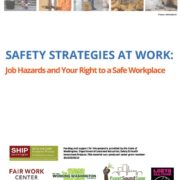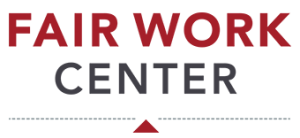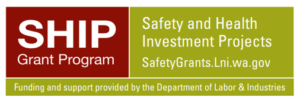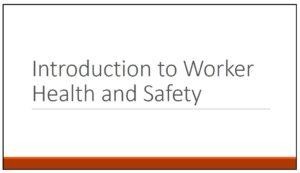From 2016-2018, Fair Work Center received a grant from the Washington Department of Labor & Industries Safety & Health Investment Projects (SHIP) Grant Program to develop a curriculum and outreach plan for providing health & safety training to hard to reach low-wage workers, including immigrants and refugees, people of color, LGBTQ people and other vulnerable worker populations. We partnered with the University of Washington to develop the curriculum and utilized our network for community-based partners to empower low-wage workers to know they have the right to a healthy and safe workplace.
We are sharing the resources we produced below so that others in our network or around the country can benefit from the work we produced and reach the hard to reach workers in their own communities.
"Safety Strategies at Work" - 1-hour training curriculum
The one-hour training curriculum, “Safety Strategies at Work: Job Hazards and Your Right to a Safe Workplace”, focuses on building awareness around the connection between workplace hazards and health and includes action-oriented messages meant to develop attitudinal change around workers’ abilities to take action to improve the health and safety of their workplaces and/or prevent future risks.  The curriculum is organized as follow:
The curriculum is organized as follow:
- Introduction to health and safety on the job. The introductory section of the curriculum establishes a supportive learning environment, engages the audience, and introduces the training topic.
- Worker Rights. This section came out of feedback from the pilot training of the one-hour curriculum with the CBOs, and it was evident that the training would be inadequate without the information on worker rights for underserved workers. The section emphasized the employer’s responsibility for maintaining a safe workplace and aims to educate participants on their rights under Washington State Division of Occupational Safety and Health (DOSH). It focused on workers’ rights under three primary categories: the right to information, a safe workplace, and to take corrective action.
- Identifying hazards on the job. This section links together the connection between workplace exposures and health by generating discussion about the hazards workers face each day and and potential effects they may be experiencing. This section introduces workplace scenarios to utilize a problem-solving approach to learning and bolsters the relevance of the discussion for workers.
- Understanding effective safety strategies. Safety strategies are ways to reduce or eliminate hazards in the workplace and offer a systemic approach to reducing illness and injury. In this section, participants work in small groups to discuss worker stories and scenarios illustrating hazardous situations. The focus of this section is to learn how to prioritize hazards and safety strategies and to instill the message that employers have a significant role and responsibility for making changes in the workplace to reduce hazards and prevent injury or illness.
- Taking action. This section provides workers with resources and allows workers to practice prioritizing strategies for mitigating hazards in the workplace. It reiterates the potential barriers to make realistic and effective change.
Conclusion. The curriculum concludes with a re-examination of the workshop assessment from beginning of the training where workers reflect on their knowledge acquisition.
Resources and handouts
These resources accompany the health and safety trainings and problem-solving clinics.
Reports evaluating the trainings and problem-solving clinics
These reports were authored by graduate students at the University of Washington Department of Environmental and Occuapational Health Services.


